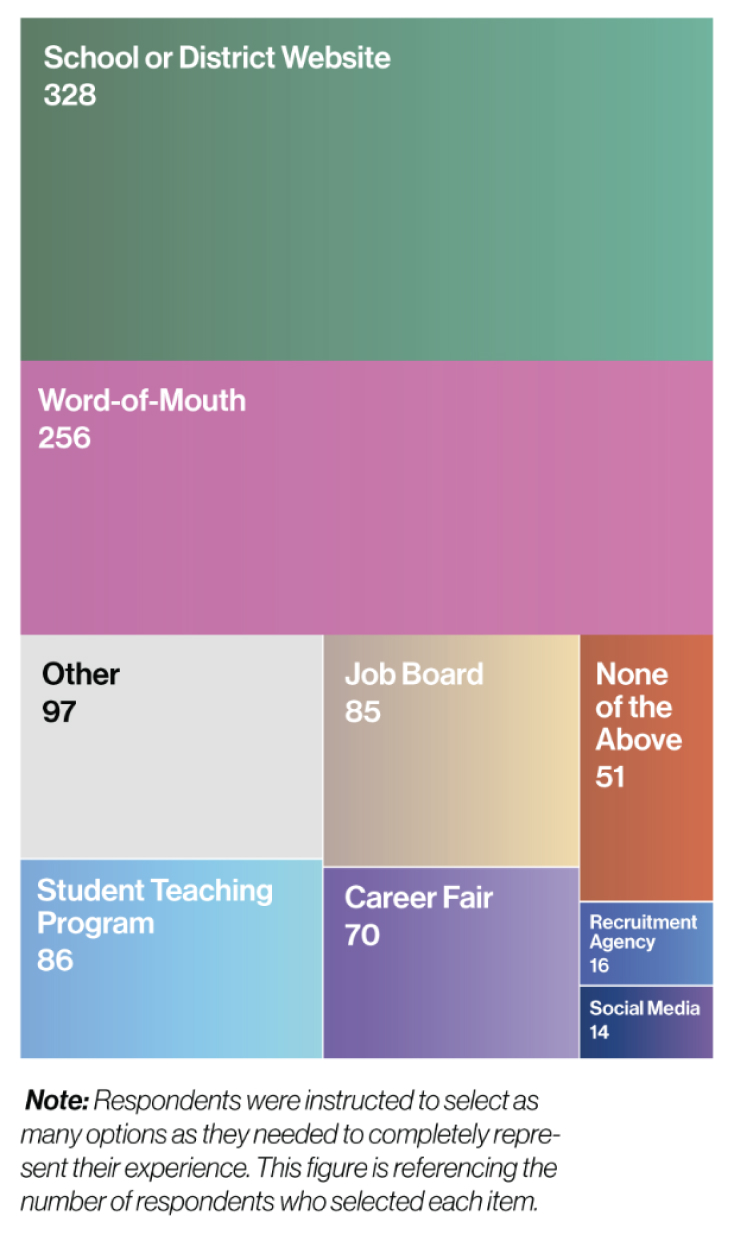Introduction
We’ve all seen and experienced it: that one video that went viral overnight or the new, upscale restaurant blowing up on Instagram. It catches our attention. It excites us. But most importantly, it gets us talking. When something resonates with us—whether it’s a form of content, an unforgettable moment, or excellent customer service—we’re inclined to share that experience with others.
This is the dream scenario for any brand, including your district. As a school leader, your job is to shape the narrative of your schools: to minimize the negative voices and amplify the positive ones. But you don’t just want people to talk. You want your community to share the great experiences they’re having with your district. There’s a term for this. It’s called word-of-mouth marketing or WOMM.
Why word-of-mouth marketing?
Word-of-mouth marketing is when people talk to others about their experiences with a brand. Most people assume this chatter happens primarily in digital spaces, but actually, the opposite is true. Only 6% of word-of-mouth happens online. Everyone talks about how much time people spend online but if you think about everything you do in a given day, a lot of that time is spent offline.
There are a couple of reasons why word-of-mouth marketing matters.
A report from Kantar Media reveals that 93% of consumers trust friends and family for information about brands and services above all other forms of advertising.
According to an Invesp study, 64% of marketing executives believe word-of-mouth is the most effective form of marketing.
74% of consumers identify word-of-mouth as a key factor in their purchasing decision.
Out of the top five popular ways to recommend a business, in-person word-of-mouth comes first, followed by Facebook, Google, and Twitter.
While other forms of marketing, like social media and paid advertising, have their place, there’s no question WOMM is one of the best ways to get your audience's attention. As skepticism for paid advertising grows, school leaders should consider spending more time and resources developing their word-of-mouth marketing strategies.
This is especially critical in teacher recruitment, as teachers talk about their experiences with other teachers. In SchoolCEO’s latest teacher satisfaction survey, we found that more than a quarter of respondents reported learning about their first jobs in their current districts through word-of-mouth (more than any other avenue besides school websites).

Jonah Berger, a marketing professor at the Wharton School at the University of Pennsylvania, has spent more than a decade studying this topic. In his bestselling book Contagious: Why Things Catch On, he outlines six key STEPPS to drive word-of-mouth marketing:
Social currency
Triggers
Emotion
Public
Practical value
Stories
While all six of these STEPPS are important, I’m only going to focus on three (social currency, triggers, and stories) and how you can apply them in your district.
Social currency
Social currency is a term you’re probably familiar with. It essentially refers to your influencer power and credibility. Social currency is about how you look when you share something. For instance, you may talk about a new hole-in-the-wall restaurant with your friends because you want them to perceive you as a foodie. Or you might share information about new legislation with your Twitter followers because you want them to think you’re politically savvy. The point is, we’re all motivated to share information that makes us look cool, smart, rich, funny or any other way we might want people to see us. We also share information that closely aligns with our values. This, in essence, is social currency.
No matter how we want to be perceived, we all have one thing that unites us: We want to be the first. The insiders. The ones in the know. In Contagious, Berger uses the example of New York City’s hidden speakeasy Please Don’t Tell: a bar hidden inside a hot dog restaurant, accessed through a small old-school phone booth. Please Don’t Tell has no street sign or advertising— yet, every night, it’s full. Why? Because Please Don’t Tell is a secret. Once you’ve had a chance to visit this hidden gem, you can’t help but tell your friends about it.

Nike’s limited-release sneaker community is another example. Sneakerheads have to take extensive steps, like joining Nike’s member list, downloading the SNKRS App, and following Nike on Twitter (among other steps) to even have a shot at scoring the shoes they want.
“Scarcity and exclusivity boost word of mouth by making people feel like insiders,” Berger writes. “If people get something not everyone else has, it makes them feel special, unique, high status. And because of that they’ll not only like a product or service more but tell others about it. Why? Because telling others makes them look good. Having insider knowledge is social currency.”
How schools can apply social currency
No, you don’t have a hidden bar in your schools. But what if you transformed an unused storage closet into a photo booth where students can take pictures and post them using a special school hashtag?
Sometimes it can feel like the detractors in your community hear and share information first. But what if you flipped the script? Build an I heard it through the grapevine email or SMS list. Use it to share insider district knowledge with a small group of community advocates before you release it to the general public.
Takeaway
How do you take the ordinary things happening in your district and make them feel exclusive, limited, and special? How do you create secrets in your community people can’t help but share?
Triggers
Berger defines triggers as “stimuli that prompt people to think about related things.” He uses the example of peanut butter: When you think of peanut butter, you automatically think of jelly. When you think of pumpkin spice lattes, you think of fall. The key factor here is timing. At any given moment some brands are more top of mind than others. This has to do with external factors like time of day, sights, smells, and seasonality.
In Contagious, Berger shares the example of music researchers Adrian North, David Hargreaves, and Jennifer McKendrick. They hypothesized that certain types of music can affect buying behavior at supermarkets. In their study, they replaced generic supermarket tunes with music from other countries. What they discovered was interesting. On days they played German music, more people bought German wine. French music meant more purchases of French wine. These findings reveal that triggers—even something as simple as music—played at the right time and place can influence behavior.
Here’s the best part about triggers as they pertain to your schools. You don’t have to have the flashiest programs or newly renovated buildings for triggers to be effective. You can be a small school located in a rural area and still make triggers work for you. All you have to do is find a trigger that will make people think of your schools. As Berger puts it, “top of mind means tip of tongue.” In other words, it’s not whether we like something or not. It’s whether we’re thinking about it at the right time or not.
For example, most people would assume Disney has more word-of-mouth than Cheerios, but the opposite is true. Berger analyzed how many times Cheerios and Disney World were mentioned on Twitter and found that Cheerios are actually mentioned more frequently. Not only that but Cheerios are often mentioned during a specific time of day, which you probably can guess: the morning.

How schools can apply triggers
Think about an initiative you’re wanting to launch. Maybe you want to encourage parents and caregivers to spend more time reading out loud with their kids. How can you create a trigger for an initiative like this? Example: Reading is for days that end in “Y.”
Brainstorm a time of day, week, or season your community is most likely to think about your district. For instance, your community probably thinks about your district during peak game nights of the week like Thursday or Friday night. Or maybe it’s during pick-up and drop-off time at school. How do you create a trigger (an experience or moment) out of these key times that will make your community think and talk about your schools? You can have several “whens.”
Takeaway
What whens can your district own?
Stories
People are more inclined to share a story over information or facts. As Berger puts it, “stories are the currency of communication.” Stories are easier to remember, and they build an emotional connection with your audience. Feel-good chemicals like dopamine, serotonin, oxytocin, and endorphins are released in our brains when someone tells a good story. There’s a lot of research on the internet about the power of storytelling. You probably don’t need convincing that it’s an effective form of marketing.
Here’s why stories work for word-of-mouth. The best stories have a moral, or nugget of wisdom that comes with them. “People don’t think in terms of information. They think in terms of narratives,” Berger writes. “But while people focus on the story itself, information comes along for the ride.”
Berger calls this nugget of information that comes along for the ride a “kernel.” The fable of “The Boy Who Cried Wolf” has a kernel: don’t lie. “Beauty and the Beast” has one too: value inward beauty over outward beauty.
Brands can tell stories with kernels of information, too. In Contagious, Berger uses the example of Blendtec’s Will it Blend? campaign. The campaign is a video series of Blendtec’s CEO, Tom Dickson, blending unusual objects in their blenders—everything from iPhones to glow sticks to golf balls to diamonds. The campaign was so successful, some of its YouTube videos garnered over 12 million views. While these videos definitely make you laugh, the kernel is clear: Our blenders are powerful, so why wouldn’t you buy them?
One district that’s incorporated kernel storytelling well is Tyler ISD. When Tyler ISD needed to fill vacant bus driver positions, they used their buses to carry their message. They came up with a few catchy slogans like, “Transporting Tyler’s Precious Cargo: Kids,” “We Want You to Drive for the Kids of Tyler,” and “Parents Do This for Free; We’ll Pay You!” It didn’t take long for their campaign to catch fire and spark conversations.

“Our goal was not just to be cute—although our slogans were very cute—but also to challenge the narrative of what it means to be a bus driver,” Jennifer Hines, communications director for Tyler ISD told us.
Since the launch, they’ve managed to accomplish their main goal: fill every bus driver vacancy. But also shared a kernel of truth with their community: being a bus driver has a significant purpose. Bus drivers get to build relationships and leave a lasting impact on students.
Read the full story here: Vehicles for Change
How schools can apply stories
Think about your kernel. What do you want people to believe about your schools? For example, maybe your workplace culture is amazing. You have staff members and teachers that have been at your district for years—even decades. Your kernel could be: “When people join our district, they stay.”
Once you know your kernel, think about a story(s) that reinforces this idea. You don’t have to make it up. If your schools are living this principle out, chances are, people are telling stories about it. Your job is to capture these stories and share them with your community in a strategic, thoughtful way.
Takeaway
“The best storytellers start with the ending,” Berger says. First, think about your kernel or idea you want to get across. Then think about the story you can tell about your district to convey this idea.
Want to know the best thing about word-of-mouth? It’s available to everyone. And it doesn’t require millions of dollars spent on advertising. It just requires getting people to talk.”
As you think about how to apply social currency, triggers, and stories in your word-of-mouth marketing strategy, I want to leave you with one final thought. WOMM is all about encouraging others to talk, but in order to apply this strategy, you have to listen and look. Look for opportunities to create secrets people can’t help but share. Look for whens that your district can own. Finally, listen to the stories your community is already sharing about your district. Your kernel is already out there. It isn’t a new idea—it just needs language to define it and a great story to make it memorable.
Read more Apptegy resources

Mastering School Communication in the Digital Age

Six Charts That Changed the Way We Think About School Communication
